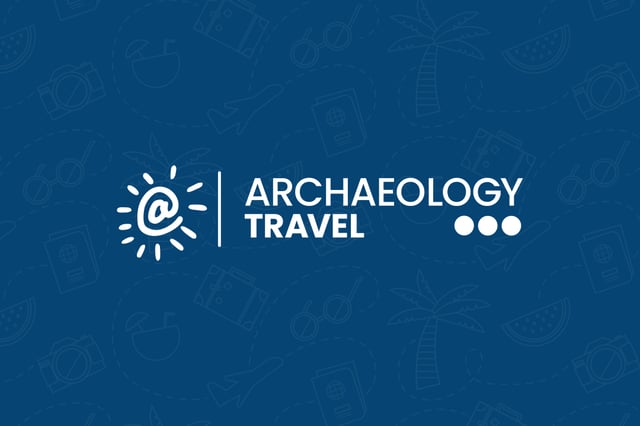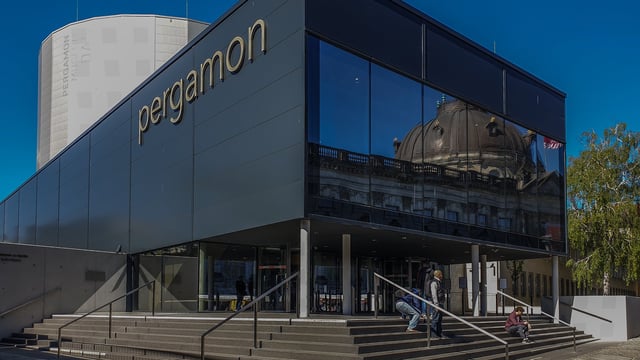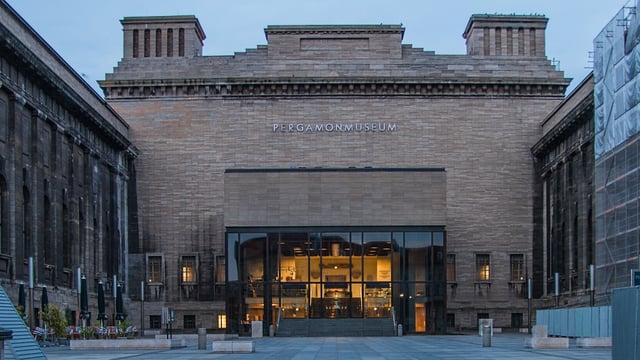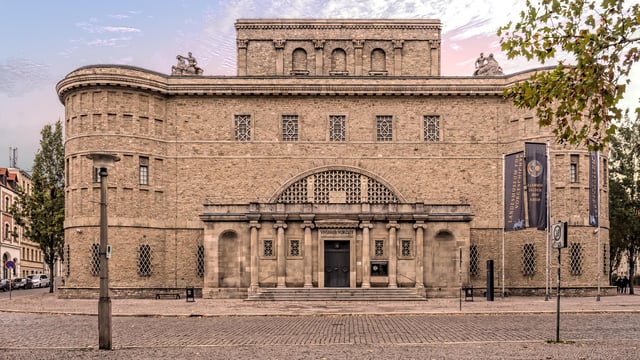Roman Museums in Germany
Some of the oldest collections of Roman artefacts in Germany were acquired by the kings of Prussia and Bavaria, amongst others. Collections that are now on display in the prestigious museums of Berlin and Munich. At some Roman sites visitors will find exceptional onsite exhibition facilities, such as Varusschlacht and Saalburg. And throughout Germany, certainly those areas that were in the Roman Empire, there are also regional museums displaying local Roman antiquities.
Altes Museum, Museumsinsel
Built in the 1820s, Berlin’s Altes Museum, or the ‘Old Museum’, was the first of the five museums to be constructed on Museumsinsel. Still today it is considered one of the most important Neoclassical buildings in the city. A fitting context for the state’s Collection of Classical Antiquities, which includes numerous Greek, Etruscan and Roman objects ranging from the 10th century BC to the 3rd century AD. Also on display are some 1,300 antique coins from the Numismatic Collection.

Archäologische Staatssammlung, München
CLOSED UNTIL 2023/24
Founded in 1885, the State Archaeology Collection of Bavaria is one of the largest and most important archaeological collections in Germany. There are five collections: prehistory, Roman, medieval, the Mediterranean and numismatics. The museum, with extensive permanent exhibits is located in central Munich in walking distance of the Marianplatz, and is normally open to the public everyday except Mondays.

Arts & Crafts Museum Hamburg
One of Europe’s most important museums showcasing the applied arts, with arts and crafts, interior design and photography from Europe, Asia and the Middle East. The museum also has important collections of ancient Egyptian, Greek and Roman artefacts on display. Over 4,000 years of applied arts are displayed in galleries spread over three floors in a building that was intended to resemble a neo-renaissance palace. Some of the highlights include a 5th century BC krater from Apulia, Etruscan reliefs, the red Speigel Canteen and an example of the ‘New Frankfurt’ fitted kitchen.

Bode Museum, Museumsinsel
Opened in 1904 this the fourth of the five museums on Museumsinsel was intended to display the state’s collection of ‘Old Masters’ and Christian era sculptures. It was damaged during the 1940s and was extensively reconstructed and refurbished, then renamed and reopened in 2005. Today exhibits include the Sculpture Collection and Museum of Byzantine Art, and over 4,000 coins and medallions from the Numismatic Collection.

Celtic Roman Museum, Manching
The Bavarian town of Manching is situated on what was a large, late Iron Age city-like settlement – the Oppidum of Manching. Excavations have recovered spectacular Celtic artefacts, including a hoard of 483 Celtic gold coins. The Iron Age settlement was founded in the 3rd century BC and abandoned in the mid 1st century BC. The strategic position made the site attractive to the Romans. Today, the Kelten Römer Museum Manching showcases the best artefacts from the Iron Age and Roman periods of the area.

Germanisches Nationalmuseum, Nuremberg
With 26 different collection areas, all represented in the permanent display, this is the largest museum of culture history in the German speaking region. Displays range from early Stone Age artefacts to the art of 20th century – with an impressive set of the so-called ‘degenerate artists’. There are an estimated 25,000 artefacts on permanent display. Some of these are of international significance. For example, the Behaim Globe made in 1492 is the oldest surviving terrestrial globe in the world. Other objects of note include the Bronze Age gold cone from Ezelsdorf-Buch and the exquisite Roman parade helmet found in Middle Franconia.

Glyptothek, Munich
Built for Ludwig I, the Glyptothek housed the Bavarian king’s collection of Greek and Roman sculpture, and is Munich’s oldest public museum (opened in 1830). Outstanding pieces of Greek and Roman marble statues are displayed in galleries modelled on a Roman bath house, with bare brick walls and high vaulted ceilings. The objects range in date from the from the archaic age at 650 BC to the end of the Roman era around 550 AD. Highlights include the Barberini Faun and the temple figures from Aegina.

Limesmuseum, Aalen
On the site of the largest cavalry fort north of the Alps in the present-day town of Aalen, is the Limesmuseum. One of the largest Roman museums in Germany. The museum not only displays artefacts excavated from the fort, especially well preserved weaponry, but also artefacts from other nearby excavations of Roman sites. A series of permanent exhibits show what both military and civilian life was like in the area about around the 2nd century CE. The museum hosts regular events, for children and adults.

LVR-RömerMuseum, Xanten
A life-size protective structure has been erected over the ruins of a bath house, that resembles the outer appearance of the Roman building. The LVR-Römer Museum is housed in what would have been the entrance hall to that building. Visitors are able to view the foundations and various features of that 2,000 year old bath house, as well the exhibition of the many objects found in and around the Colonia of Roman Xanten. Displays are organised chronologically, and tell the history of this important Roman city.

Museum of Classical Antiquities, Leipzig
Housed in the Alte Nikolaischule, the University of Leipzig’s Museum of Classical Antiquities has over 10,000 artefacts from various Mediterranean countries representing Classical Greece and Rome. Although the collection was founded in 1840 as a teaching collection for students of Classical archaeology at the university, the museum is accessible to the public. Highlights include a number of red and black painted ceramics from Apulia, including a beautifully decorated Apulia Krater.

Neues Museum, Museumsinsel
The ‘New Museum’ was completed in 1855, but suffered considerable damage during World War II. After a major refurbishment it re-opened in 2009. The museum houses three collections: the Egyptian Museum and Papyrus Collection, the Museum for Prehistory and Early History, and the Collection of Classical Antiquities. One of the most celebrated pieces is the bust of Nefertiti.

Pergamon 360
In a circular rotunda 30 m high, visitors can view a 360° panorama of the Graeco-Roman city of Pergamon. The ‘snapshot’ is from a day in 129 AD, a day on which the festival of the god Dionysos was held and the city was visited by the Roman Emperor Hadrian. The enormous image, which you climb a central tower to experience at different heights, was created by Yadegar Asisi and is based on the current state of archaeological knowledge. Also on display are important pieces from the Pergamon Collection. This attractions is open while the Pergamon Museum is closed.

Pergamon Museum, Museumsinsel
The last of the five museums built on Museumsinsel, The Pergamon Museum was built to house the Pergamon Altar. Other highlights include the Ishtar Gate and the Market Gate of Miletus. The museum also displays objects from the Collection of Classical Antiquities, the Museum of the Ancient Near East, and the Museum of Islamic Art. Currently being refurbished to add a fourth wing, the museum is closed until at least 2027.

Rheinisches Landesmuseum, Trier
Founded in 1877, this state museum exhibits artefacts from prehistory to the Baroque period, some 200,000 years of history from stone tools to elaborate Medieval art. Not surprisingly, a major focus of the museum is the Roman period, for which there are numerous displays that draw on the many archaeological finds excavated in Trier that tell the story of the Roman city of Augusta Treverorum. One particular highlight is the Trier Gold Hoard, found in 1993 it is the largest known hoard of Roman gold coins.

Romano-Germanic Central Museum, Mainz
In June 2017 the Roman-Germanic Central Museum housed in the Electoral Palace of Mainz closed to the public in preparation for the move to Neutorstraße. Expected to open in 2024, there will be around 200,000 artefacts displayed in a new, state-of-the-art facility covering an estimated 14,500 square meters of exhibition space.

Römisch-Germanisches Museum, Cologne
The Romano-Germanic Museum in Cologne is one of Germany’s most important Roman museums. During construction builders came across the remains of a Roman town house. During rescue efforts, the spectacular Dionysus mosaic floor could not be lifted so it was decided a museum would be built around the mosaic. Besides extensive exhibits of art, culture and everyday life in Roman and early medieval Cologne, the museum has largest and finest collections of Roman glass artefacts in the World. Although the museum is currently being renovated, exhibits are on display in a temporary venue (see the website for details).

Staatliche Antikensammlungen
Based on the collections of the Bavarian King Ludwig I, the State Collections of Antiquities displays art and everyday objects of ancient Greek, Etruscan and Roman origins. The earliest objects are from the Aegean islands of the 3rd century BC, Cycladic culture, and the most recent from Late Antiquity in the 5th century AD. The collection, and display, is particularly well known for its fine collection of Athenian painted vases, but there are also jewellery and glass, portraits and gems on show.

State Museum for Prehistory, Halle
The Landesmuseum für Vorgeschichte in the city of Halle is one of the most important archaeology museums in Germany and Central Europe. Although named for prehistory, the exhibitions based on a collection of over 15 million artefacts cover 450,000 years of human history, from the beginning of the Stone Age to the early modern period. Some of the most important objects include the Nebra Sky Disc, the rider stone from Hornhausen, the Bad Dürrenberg shaman and the family graves from Eulau.

State Museum of Egyptian Art
What the museum lacks in numbers of artefacts it more than makes up for in the quality and significance of objects on display. In displaying some 5,000 years of art in Egypt, the following periods are included: the early, middle and late kingdoms, as well as Hellenistic, Roman and Coptic era of Egypt. Rather than a chronological presentation, displays cover a range of themes in Egyptian art and culture. Since 2013 the museum has been at the centre of the Kunstareal, along with the other major museums in Munich.

Terra Sigillata Museum
During the 2nd and 3rd centuries AD Rheinzabern, then called Tabernae, was probably the most important centre for the production of fine ceramic tableware, known as Terra Sigillata. Not only was the area rich in necessary raw materials required for the production of ceramic vessels, both clay and wood, the favourable transport conditions afforded by the Roman Rhine Valley Road, ensured great commercial success for the town. The museum explores pottery production during the Roman period, and visitors can take a guided tour to the nearby Roman Kilns.





















